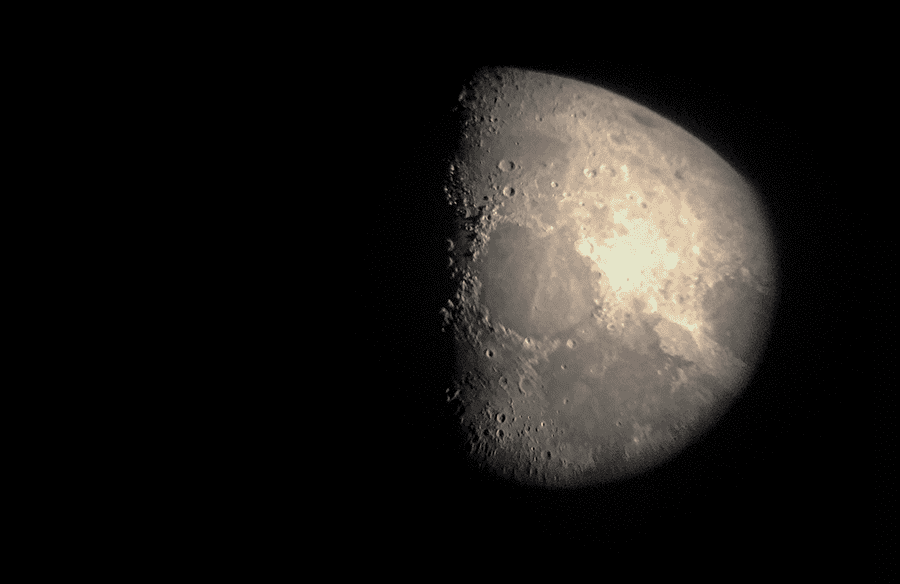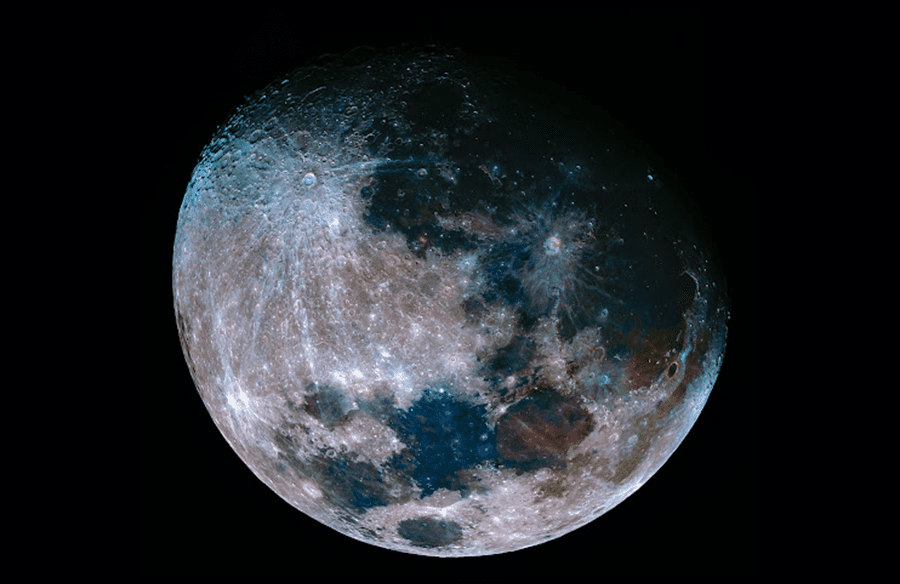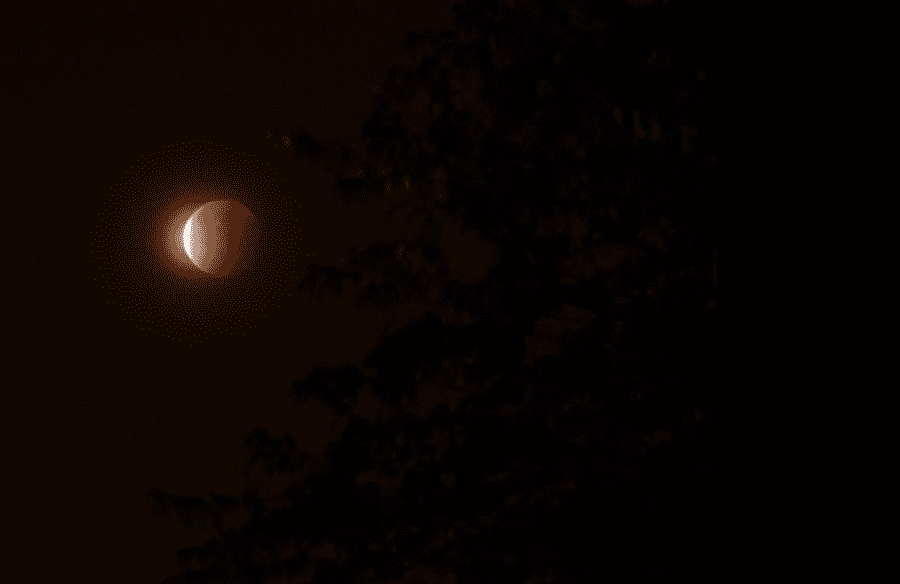Why does the moon shine? is one of those seemingly simple questions that people tend to assume they were born with the knowledge to answer, like ‘why is the sky blue?’ That is until someone – usually a young child – asks them the question.
But fear not, nobody is born with this knowledge, so I am about to answer this question and a few related ones to save any future embarrassing silences at the mercy of inquisitive children!
The moon does not have a light source; so it does not shine itself, like a lightbulb or burning hot coals shines. The moon shines because it is reflecting the light of the sun, and to a much lesser extent from Earthlight which itself is reflected from the sun!
If you were to see the moon in isolation, far from any sunlight, it would, in fact, look totally black. The outer surface of the moon, which is called the crust, is made of similar materials that you find on earth (if we stripped back the top soils) and also of volcanic lava. Those most common components are basalts which are rich in Iron and Magnesium and also the elements Calcium and Aluminum.
Earth, on the other hand, is mostly covered in stuff like trees, lots of water, and nowadays, some man-made substances, so different parts of the surface reflect light differently. Nonetheless, you would not really expect any of these materials to shine but they do – read on to discover why and how we measure this shininess!
Contents
How Bright is the Moon?
So just how reflective is the moon, then? To answer that, we have to learn about Albedo– a word you may not have encountered before. Albedo is a scale from 0 to 1 which describes how reflective a surface is.
A perfect reflector- say, a very finely polished mirror would have an albedo of very close to 1, or 100% of light reflected. In nature, fresh snow has about the highest albedo at 0.96 (96%). A perfect absorber of light would have an albedo of zero or (0%). In nature then, charcoal comes closest to that at about 0.04.
So what does this tell us about the brightness of the moon? Well, the albedo of the moon’s surface from space is about 0.12, so only 12% of the light hitting the moon from the sun is reflected back. The sun, as you may have noticed, is rather bright so even at only 12% the moon shines pretty bright!
Of course how bright the moon appears to us earthlings is also dictated by its phase– a full moon will reflect back more of the sun’s light than a crescent moon because you are seeing less of the moon.

Okay, so that’s how much the moon reflects light, but what about answering the question of how bright it actually is as seen from Earth? Well, that brings us to another word – magnitude. We use magnitude to measure the brightness of celestial objects as seen from Earth; confusingly, this scale works in reverse- the lower the number, the brighter the object!
This system dates back to an ancient Greek astronomer or two, more than 2000 years ago. The reason I think it made sense to them to use what we might call a ‘reverse’ scale is that the astronomers of that time wanted to describe the brightest stars in the sky as ‘1st magnitude’ stars, with dimmer ones, ‘2nd magnitude’, ‘3rd magnitude’, and so on.
This then means that anything brighter than the brightest stars- say, the sun, planets, or the moon, must go into negative numbers! Also, the scale is not linear. Look, it’s complicated, and I won’t go into detail in this article for fear of losing my audience, suffice it to say a magnitude 2 star is 2.5x dimmer than a 1st magnitude star. The faintest stars we can see with the naked eye are about magnitude 6.
The full moon then is magnitude -12.6 – that’s how bright the moon is, and the sun is magnitude -26.7 that’s approximately 40-55 x brighter than the moon!
What Color is the Moon?
A trick question, right? It’s white, isn’t it? Or maybe a bit orange at certain times or once in a blue moon, blue? Well no. Firstly, as anyone who has ever tried to choose a shade of paint knows, perceived color changes according to the source of the light, so in a few billion years, when our sun becomes a red giant, the moon will look somewhat red (just before being destroyed by the sun, but that’s another story).
Also, different parts of the moon’s surface reflect back different colors, for example, parts of the moon that consist of the mineral cobalt will give a blue color, and areas rich in iron a rusty brown color.

From the earth, however, all these colors combine and just look white. Think of a large television on a wall. As you sit watching the TV, the image is full of different colors, but what happens when you see that same TV from a few streets away?
It just looks like a white/bluish dot flickering away in the distance. The light reflected back from the moon is also very bright so it overloads our eye’s color receptors, and we just see white, which is a mix of all colors.
It is, however possible, with some rather clever processing techniques, to show the actual real colors of the moon as we would see them if we were not being dazzled by 12% of the sun’s light reflected back onto our face. Such images are called Mineral moon images and can be created from just about any close-up sharp photo of the moon.
How Bright is Planet Earth and Does the Earth Shine on the Moon?
So that’s cool. We now know how bright the moon is, but we’ve all seen that famous picture of a beautiful bright glowing earth rising above the moon’s horizon, taken on the Apollo 8 mission in 1968, so how bright is the earth as viewed from the moon?
Well this does vary a bit, depending on what part of the earth you are looking at-. Remember albedo? Snow, clouds, mountains, and the sea all have different albedos, so will reflect different amounts of light back. If you are far enough away, this won’t matter much, but if you are close enough- say from the moon, which bit of the earth is facing you will make a small difference.

Photo copyright NASA, from https://www.esa.int/
The answer is that the Earth is up to 55 times brighter than the Moon. The Earth has an albedo rating of 0.37, reflecting back 37% of the light it receives from the Sun.
Lastly, all that light reflecting off the earth does actually contribute to some of the brightness of the moon. It’s called earth-shine, and it’s why if you look at the moon through a telescope or binoculars when it’s in phase or during a lunar eclipse, you can still faintly see the shaded part of the moon. What you are seeing is sunlight reflected off of the earth, reflected back from the moon! Yes, you can lie down now and ponder that one for a while.

Conclusion
So now you know- the moon does not actually shine; really, it is reflecting the sun’s light, and it reflects only 12% of the light it receives. If the moon were kicked out into deep space far away from the sun, it would be very hard to find as it would look completely black (hopefully, any spaceships out there will have good headlights anyway).
The earth also shines as seen from the moon, and the moon is also really colorful, not just white. So next time that child comes up to you and asks you why the moon shines, you’ll have an answer – I’ll just leave it up to you how much of that answer you want to give.

